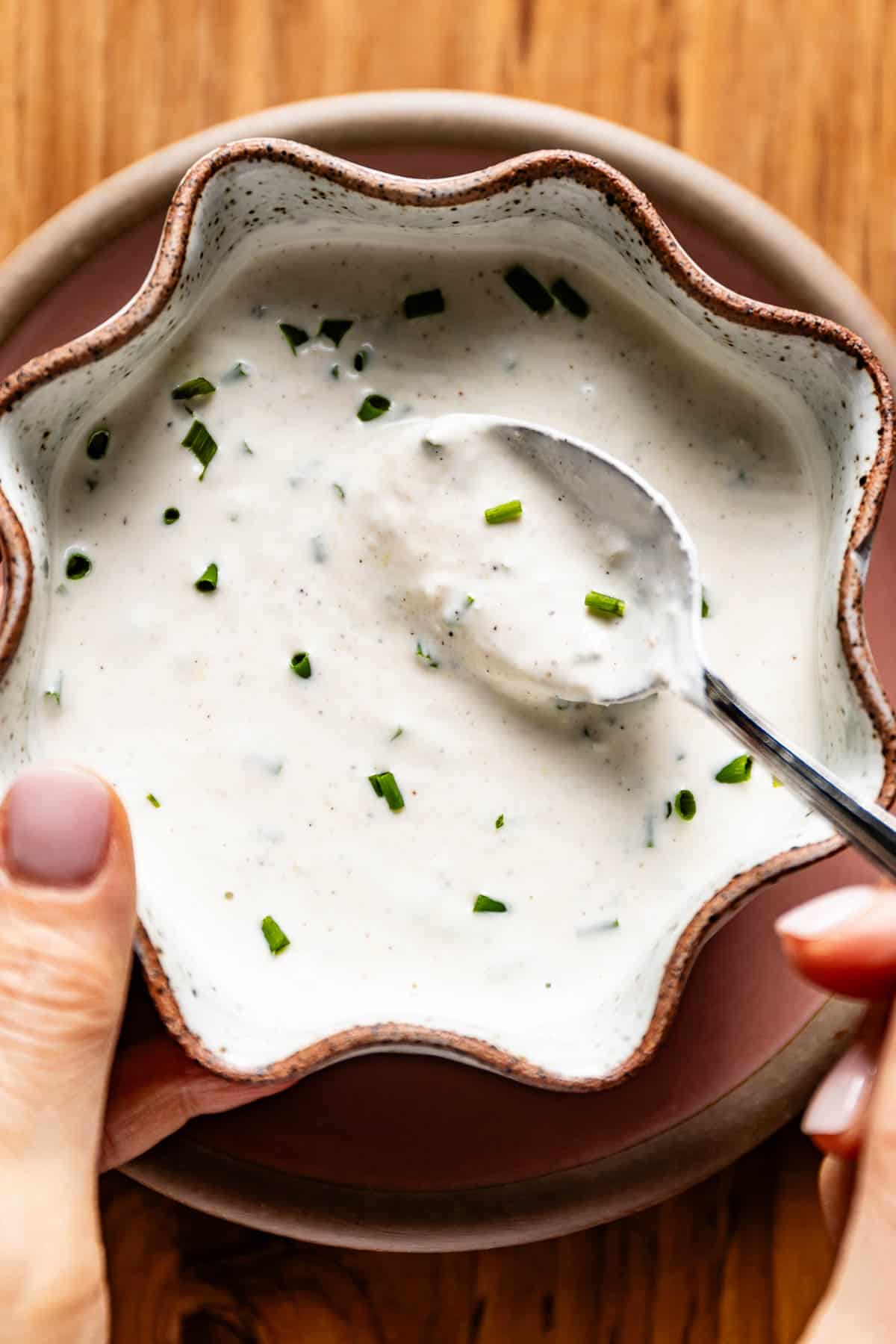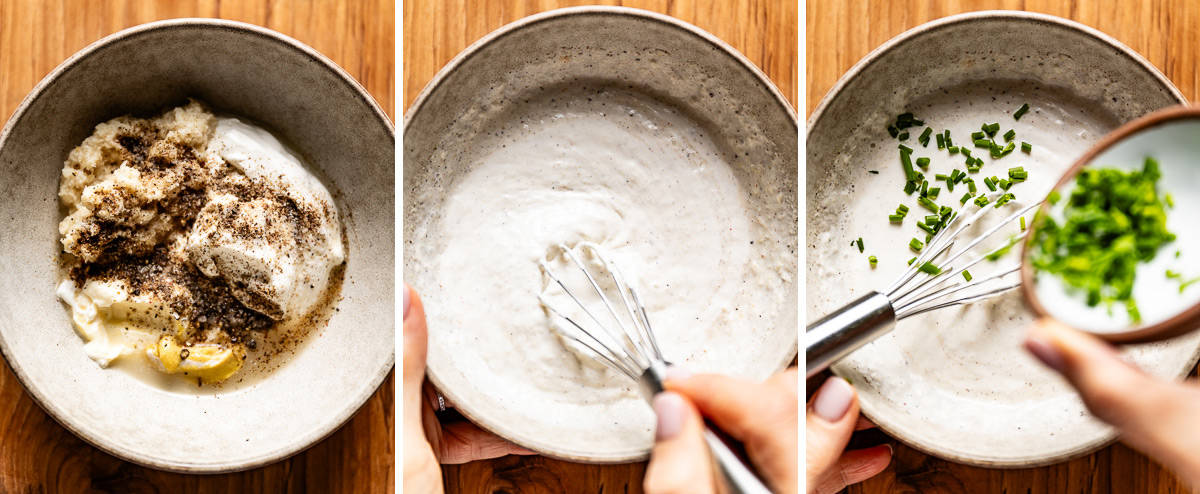Prepared horseradish: Often referred to as “prepared horseradish” or “horseradish grated in vinegar,” you can likely find this root vegetable at your local grocery store in a jarred form. In essence, prepared horseradish comes together with grated horseradish root stored in vinegar, which helps release the raw horseradish’s natural juices. If you prefer not to use store-bought varieties and are growing fresh horseradish root at home, you can also prepare horseradish from scratch. However, please note that horseradish sauce with homemade horseradish will have a stronger flavor, so I suggest adapting your recipe accordingly. Sour cream: One of my favorite ingredients in this horseradish sauce, tangy sour cream helps balance the root’s spicy, bold notes with a milky, rich taste. In particular, I recommend using full-fat sour cream to achieve the creamiest flavor. Mayonnaise: Mayonnaise makes an excellent addition for those who prefer a tangy horseradish dip recipe, lending an extra layer of creamy, mildly sweet flavor. However, it is optional, so you can make this horseradish sauce without mayonnaise if you want. Apple cider vinegar: With a bright, zippy edge and a subtle sweetness, apple cider vinegar is a great way to balance the full-bodied richness of this creamy horseradish dressing. However, white wine vinegar or champagne vinegar would also work. Dijon mustard: Though optional, the addition of Dijon mustard offers a delectably spicy, complex taste to the original dip recipe. Seasonings: A simple mix of salt and pepper is all you need to bring out the natural tastiness of this DIY horseradish sauce. Chives: Fresh chives offer mild onion undertones and a pop of color to this recipe, adding a brilliant lightness to its creamier base. Due to their similar flavors, you can also use scallions if you don’t have chives on hand.
How to Store and Freeze?
This horseradish dipping sauce recipe is a great make-ahead recipe as it stores well. My only recommendation is to store it in a super airtight container, as proper storage will ensure it lasts as long as possible.
Storage: Transfer your prepared horseradish sauce to an airtight container or a mason jar to store. It will then stay fresh in the refrigerator for up to a week. I also recommend stirring the mixture before serving to ensure none of the ingredients settle or separate. Freeze: You can freeze this horseradish dressing for up to three months when stored in an airtight, freezer-safe container. Furthermore, you can also simplify your future portioning by freezing the sauce in ice cube trays. Once hardened, you can pop out the horseradish cubes and transfer them to airtight freezer bags. Each cube will then be good for one serving.
Meat: No one can resist a pairing as classic as spicy horseradish and hearty beef dishes. This easy recipe tastes out of this world alongside nearly any kind of beef, including standing rib roast, beef tenderloin, and roast beef. If you’re a steak lover, you can also use this recipe to compliment whatever cut you’re serving, whether you want to use this horseradish sauce for a filet of beef or tri-tip steak. Or, if you’re in the mood for a gourmet and homey dish, you can even use this horseradish sauce for beef fondue or a filling Pot Roast. Pork and lamb: Using horseradish sauce for lamb (like this Lamb Chops recipe) is a fan-favorite way to bring out the meat’s naturally succulent, grassy flavors. You can also use this bold cream sauce to bring out the juicy, sweet taste of Pork Tenderloin. Sandwich spread or burger sauce: If you want to animate your favorite sandwiches with an appetizingly spicy, smooth taste, try adding a dollop of this creamy horseradish spread! This delectable dip beautifully brings out the rich, buttery base of a prime rib sandwich and the savory fill of a roast beef sandwich. You can even make it a burger sauce to use in making my Bacon Avocado Burger for a fresh-yet-robust Californian menu. Seafood: Though less common, using horseradish sauce for fish recipes is a great way to add a deliciously bold zip to your seafood main. I especially like using this dip recipe with richer fish dishes, like Baked Sockeye Salmon or Grilled Sockeye Salmon. Roasted or grilled vegetables: Creamy, spicy, and bold, easy cream sauce is a fabulous dipping sauce for cooked veggies and a boldly flavored topping for a baked potato. Sushi: Similarly pungent and spicy—but not quite as harsh—this mild horseradish sauce makes an excellent substitution for wasabi in sushi dishes. This way, you can enjoy your sushi without overpowering its taste with wasabi’s stronger flavor. Bloody Mary: Many say that a dollop of this cream sauce easily enhances an otherwise ordinary bloody mary, giving it an extra burst of flavor.
Balance the flavors based on the dish you’re serving: The best part about making homemade horseradish sauce is how easy it is to customize based on your menu. When serving this recipe with meat, I like to add a little more horseradish to better balance the protein’s heavier, more robust base. However, I prefer a mild horseradish sauce when I serve it with more delicate or complex recipes—such as roasted veggies or sandwiches—so I add less horseradish accordingly. Taste for seasoning: With so many distinct elements, it’s vital that you taste your horseradish paste before serving, adding more seasoning as necessary. This step is especially important after storage, as the flavors may develop or change while resting. Let it rest: If you have the time, I recommend making this recipe ahead of time so it has time to rest before serving. This resting period will allow the ingredients to mix more deeply, resulting in a more full-bodied, complex flavor profile. Stir before serving: Because this horseradish crema has many ingredients of varied composition and density, you must stir the sauce before serving. This last-minute mixing will ensure none of the ingredients separate while resting, giving the dip an even flavor.





